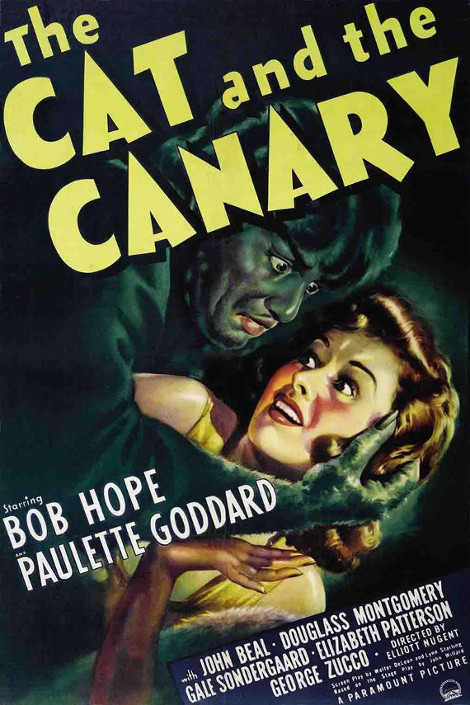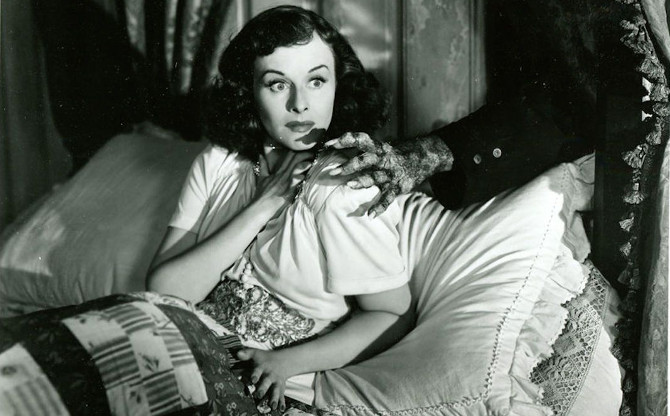A horror premise as old as it is entertaining, Elliott Nugent’s 1939 film The Cat and the Canary finds an extended family coming together for the reading of their uncle’s will – ten years to the day of his death. A remake of the 1927 silent classic (the idea came from a 1922 stage play of the same name by John Willard), screenwriters Walter DeLeon and Lynn Starling fuse the narrative with a deft comedic touch, resembling the Abbott and Costello horror features that were soon to come – movies that were magically able to play the horror parts for horror and the comedy parts for comedy.
Set in a gothic-style plantation home in the middle of the Bayou, the vines envelop the property, the alligator filled water and lush landscape swallowing the dilapidated mansion that likely once stood out, a grand example of man conquering nature. Somewhat resembling Poe’s House of Usher, the property is managed by a mysterious and menacing housekeeper, Miss Lu (Gale Sondergaard) – it is implied that she was the owner’s mistress, a woman who welcomes (and I use that word loosely), the estate’s lawyer, Mr. Crosby (George Zucco), as well as Cyrus Norman’s only remaining heirs: famed actor Wally Campbell (Bob Hope) – who keeps guessing what will happen before it does thanks to his profession, fetching Joyce Norman (Paulette Goddard), mother and daughter Aunt Susan (Elizabeth Patterson) and Cicily (Nydia Westman), as well as nephews Fred Blythe (John Beal) and Charles Wilder (Douglass Montgomery).
Introducing many fascinating horror tinged threads, the family lineage is supposedly riddled with a streak of insanity, while the lights within the household murmur as they flicker (something Miss Lu suggests are the spirits that live within the abode), and an unexplained gong ominously rings seven times, once again implied by Miss Lu that one person will not make it through the night (the same thing happened the night her master died).
Intriguingly, the house is its own character – trap doors, secret passages, a portrait with removable eyes (so that our unknown assailant can spy on those in the library), a dark old basement, barred windows, and a pesky black cat only add to the eerie atmosphere – in many ways, this could be a screen version of the board game Clue. . . it does not help that Miss Lu is constantly skulking and spying, muttering ominous prophecies under her breath (like she is part of the property, she blends into the woodwork). The group are also stranded in the home for the evening, as those guides who boated them out into the middle of nowhere will not return again til morning.
Reading the will, the eccentric millionaire has an adjunct document, a failsafe in case the person named as the heir goes insane or dies in the first thirty days. . . also providing other family members the opportunity to off the spoils-taker if they believe they are next in line. Further complicating things, a guard, Hendricks (John Wray), from nearby Fairview Insane Asylum, has warned those inside that a murderer has escaped its confines. . . a man who has giant, taloned hands, skulking around on all-fours like a cat, waiting to strike down his next victim.
On top of the millions and the extensive estate, there has long been rumoured to be a certain necklace – diamonds, gems and precious metals worth as much as everything else combined. . . another little something that everyone else would dearly love to get their grubby hands on.
Of course, the grim reaper does make a visit, and that pesky unwanted gong rings once more, this time striking six – suggesting someone else will meet their maker before dawn. Will there be another victim? Will the family be able to uncover the thieving murderer?
A perfect setting for a murder mystery, everyone is a suspect, while the inescapable nature of the crumbling property makes for a certain claustrophobia. When combined with the fact that locks and bars cannot save you, one or more of your family may be trying to kill you, and there is a deranged psychopath on the loose, it doesn’t exactly make for a pleasant, sleep-filled evening. Dousing the walls with shadowy light, Nugent and cinematographer Charles Lang (The Ghost and Mrs. Muir) further develop the spooks, those unknown hands and deformed faces merely glimpsed through their marvellous, atmospheric lighting.

The fascinating original one sheet poster for The Cat and the Canary, which clearly focuses more on the film’s horror elements than its comedic side
Aptly fusing all of these horror elements with some great comedic dialogue, the cast have some fun with the playful screenplay. A classic Bob Hope-type retort, as Wally makes his way down into the creepy basement with Cicily, she claims, “I’m psychic too – I was in a trance once”, to which the comic quickly replies, “I know. . . when are you coming out of it?”.
An entertaining little comedic horror escapade, The Cat and the Canary works like a well oiled machine. Just as memorable as those excellent episodes of The Flintstones and Scooby-Doo, Where Are You? that utilized the same plot device, it plays so well because its premise is so very much fun. Thankfully, Paulette Goddard was able to join the project as there were some delays on Charlie Chaplin’s next feature, The Great Dictator, allowing Paramount to snap her up over original lead Martha Raye, who had just been replaced by Shirley Ross (two recent Bob Hope co-stars). . . while Hope is perfection as the quick-witted coward who continuously attempts to talk himself into being brave (bumbling his way through the happenings with an almost second sight thanks to being an actor who has seen it all before), the two stars surrounded by a stellar supporting cast. Lastly, its score, written by Ernst Toch, leans more towards the horror elements than comedy – a sharp composition that never lets us forget that there are some scares coming, no matter how many one-liners we hear. So, come discover who is the cat and who is the canary in this playful murder mystery – let’s hope someone can solve the case.


